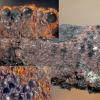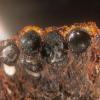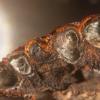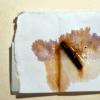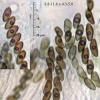
12-02-2011 10:32
 Alex Akulov
Alex Akulov
Dear Colleagues. Does anyone have access to the a

10-02-2011 13:53
Marja PennanenHello, I decided to present all new winter Orbi

08-02-2011 10:47
Quijada LuisDear Colleagues,I have long tried to get these two

08-02-2011 01:09
Erwin GruberHave another try - i am a little disappointed beca

08-02-2011 00:42
Erwin GruberFungi exsiccati praecipuae Gallici 6893 was the fi

06-02-2011 11:07
Bonjour à tous, Quelqu'un aurait-il parmi vous c

05-02-2011 01:33
 Yannick Mourgues
Yannick Mourgues
Bonsoir à tous. Afin de compléter un article, j
Hypoxylon rubiginosum?
Enrique Rubio,
18-07-2011 18:55
These resupinate stromata grow on wood of Fagus sylvatica. KOH 10% extractable pigments are orange red but peripherically purplish. Asci have an apical apparatus Mlz. negative but bluish in IKI.
Could be H. rubiginosum?
Enrique Rubio,
18-07-2011 19:43
Re : Hypoxylon rubiginosum?
Dear René:
No smell I have noted, perithecia are 375-575 microns high and stromata are small (only 3-4 cm)
Enrique
No smell I have noted, perithecia are 375-575 microns high and stromata are small (only 3-4 cm)
Enrique
Jacques Fournier,
18-07-2011 20:59

Re : Hypoxylon rubiginosum?
Hi Enrique,
I guess you studied it in detail because it seemed a bit strange to you. The results of your chromatography are indeed surprising.
I would be glad to see it and I will forward it to Marc to study its HPLC profile.
Thanks in advance,
Jacques
I guess you studied it in detail because it seemed a bit strange to you. The results of your chromatography are indeed surprising.
I would be glad to see it and I will forward it to Marc to study its HPLC profile.
Thanks in advance,
Jacques
Enrique Rubio,
19-07-2011 12:13
Re : Hypoxylon rubiginosum?
OK., Jacques. I will send you my material
Best wishes
Enrique
Best wishes
Enrique
Jacques Fournier,
28-09-2011 10:44

Re : Hypoxylon rubiginosum?
Dear Enrique,
I eventually received your specimen, thanks!
I wonder if two different Hypoxylons were not mixed up in your collection because I failed to see any purplish tinge around the orange pigments obtained on a paper with KOH, following your method.
Ascal rings also differ from what you observed in that they turn blue in Melzer and IKI as well.
I first though your fungus might be H. canariense, so far known only from Canary Islands where it is very common, in which I sometimes observed dubious reactions of ascal rings to iodine, but I do think the one you sent me is a depauperate form of H. rubiginosum.
Many undescribed species of Hypoxylon likely are still to be discovered, most of them resembling H. rubiginosum in gross morphology. Keep on screening them!
With best wishes,
Jacques
I eventually received your specimen, thanks!
I wonder if two different Hypoxylons were not mixed up in your collection because I failed to see any purplish tinge around the orange pigments obtained on a paper with KOH, following your method.
Ascal rings also differ from what you observed in that they turn blue in Melzer and IKI as well.
I first though your fungus might be H. canariense, so far known only from Canary Islands where it is very common, in which I sometimes observed dubious reactions of ascal rings to iodine, but I do think the one you sent me is a depauperate form of H. rubiginosum.
Many undescribed species of Hypoxylon likely are still to be discovered, most of them resembling H. rubiginosum in gross morphology. Keep on screening them!
With best wishes,
Jacques
Enrique Rubio,
28-09-2011 12:31
Re : Hypoxylon rubiginosum?
Many thanks for your study, Jacques
Enrique
Enrique

